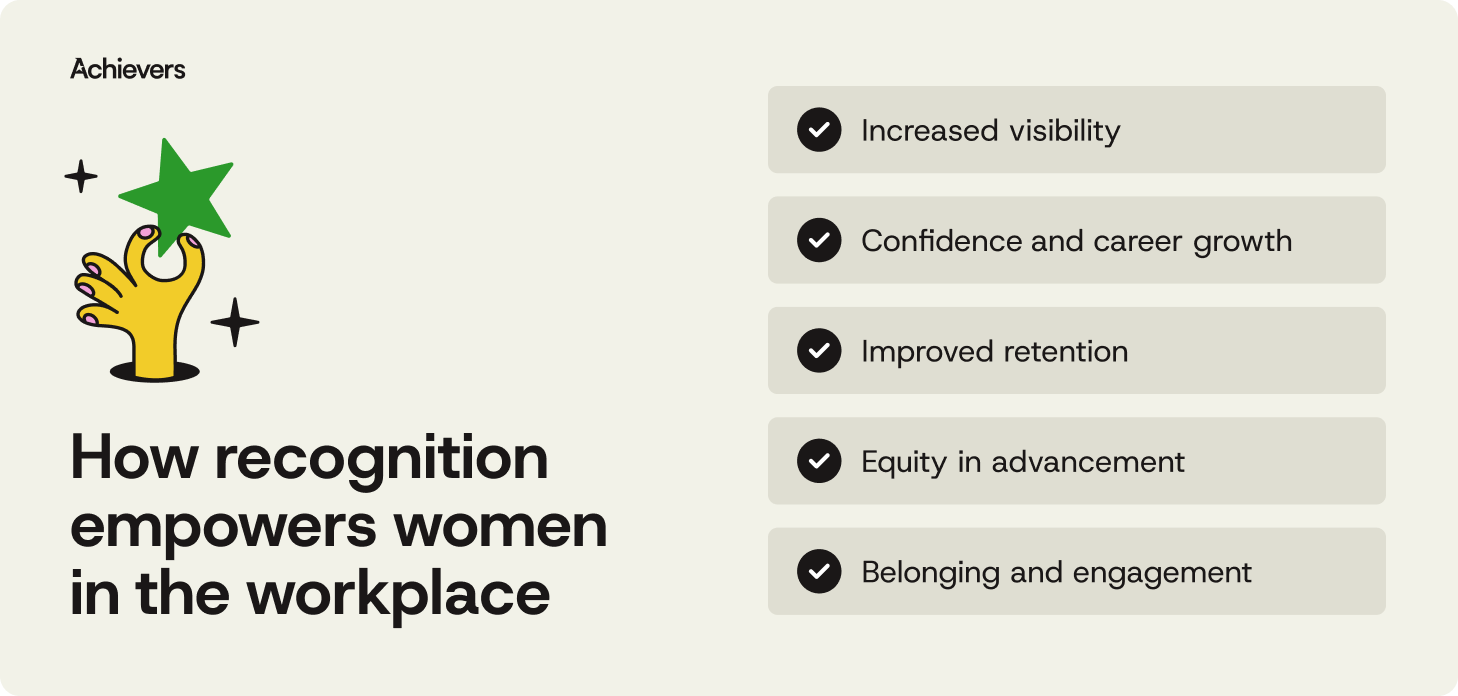Table of contents
Create a culture that means business™
Schedule a demo with an Achievers solution expert today.
Women in the workplace are driving change, leading teams, and making an impact — but they’re still facing gaps in how that impact is seen, supported, and rewarded. Days like International Women’s Day shine a spotlight on these issues, but real progress depends on what happens after the headlines fade.
And right now, that progress feels slow. Only one in 10 women say their employer is taking real action on gender equality, according to Deloitte’s Women at Work 2024 Report. That’s not just a tough stat — it’s a missed opportunity to lead with intention.
Progress doesn’t have to be dramatic to be meaningful. Sometimes it starts with something as simple as recognition — moments that say: we see you, and what you’re doing matters.
So where do we go from here? Let’s look at what’s holding women in the workplace back — and how recognition can help move things forward.
Why equity matters for women in the workplace
When it comes to equity for women in the workplace, the data hasn’t budged much — and that’s the problem.
Women remain underrepresented in leadership, the pay gap persists, and for every 100 men promoted to manager, only 87 women make that same move. For women of color, the gap is even wider, according to the latest Women in the Workplace Report from LeanIn.org and McKinsey.
But it’s rarely just one barrier. Race, caregiving, age, and job type all shape how women experience work — and those factors often stack up. When systems don’t account for that, equity falls further out of reach. You can see these gaps in how feedback is given, who gets promoted, who gets mentored — and in everyday moments that show people their work matters, like recognition.
The question is no longer whether gender equity matters. The real question is: how can companies do better — and what’s at stake if they don’t?

How recognition empowers women in the workplace
For women in the workplace, especially in roles where they’re underrepresented, visibility isn’t always guaranteed. Contributions can be overlooked, credit can be misdirected, and opportunities can quietly pass by. Recognition helps change that. With tools like Achievers’ recognition platform, recognition becomes easy to scale — built into the flow of work, visible across teams, and tied to the behaviors that matter.
Here’s how recognition plays a key role:
- Increased visibility: Recognition highlights the work that drives results — not just the work that gets the most airtime. According to Achievers’ 2024 State of Recognition Report, women say they’re recognized less often than men — and that gap matters. When recognition is frequent and fair, it boosts visibility and opens the door to new opportunities.
- Confidence and career growth: Being recognized reinforces what’s working. It builds confidence and encourages women to step into new challenges, take on leadership roles, and see a future for themselves inside the organization.
- Improved retention: Feeling valued plays a major role in deciding whether to stay or leave. When recognition is consistent and meaningful, it creates a sense of momentum that keeps women engaged — and more likely to stick around.
- Equity in advancement: Recognition tied to values and impact — not visibility or popularity — helps even the playing field. Today, women hold just 29% of C-suite roles, showing how far there is to go. Consistent recognition creates a fairer way to measure and celebrate progress, helping open more paths to leadership.
- Belonging and engagement: Recognition helps people feel like they belong. For women who often face bias or exclusion, it’s not just about being in the room — it’s about being part of the culture. That sense of inclusion builds stronger connections and drives deeper engagement across the board.
Challenges facing women in the workplace — and how to fix them
Progress is happening, but it’s uneven — and slower than it should be. Women in the workplace still face roadblocks that can quietly hold them back, even in organizations with the best intentions. These challenges don’t always show up in policy — but they’re felt in everyday interactions, missed opportunities, and uneven recognition.
Understanding where things fall short is the first step. Taking action is where change happens.
Workplace challenges
- Gender bias in evaluations and promotions: Feedback should build people up — but for many women, it does the opposite. A 2024 report from Textio found that 76% of top-performing women received negative feedback from their managers, compared to just 2% of high-achieving men. That kind of imbalance shapes careers and signals who’s seen as “leadership material.”
- Disproportionate caregiving responsibilities: Outside the office, many women carry most of the caregiving responsibilities — affecting their time, energy, and how they’re perceived at work, especially in workplaces that still reward visibility over impact.
- Gender discrimination: Discrimination still shows up — in hiring, in promotions, in how feedback is delivered. In fact, an article from the ALA Allied Professional Association found that many women report being treated differently because of their gender, which affects how they’re seen and how far they can go. That means bias, even when subtle, has a lasting impact.
- Limited access to mentors and sponsors: Growth often depends on who’s advocating for you — and not everyone gets the same access. When mentorship and sponsorship aren’t actively supported, women can miss out on development opportunities that fast-track careers.
Workplace solutions
- Make recognition part of the system: Recognition that’s tied to values and behaviors helps level the playing field. It makes contributions visible — not just to managers, but across the organization — and reinforces what success looks like.
- Flexible work and work-life balance: Flexibility helps women manage work and life — especially when caregiving is part of the picture. It’s not just a benefit; it’s a practical way to support equity. When it comes with clear expectations and real support, flexibility gives women room to grow their careers without hitting burnout.
- Train managers to lead with inclusion: Inclusive leadership doesn’t happen by accident. Managers need training to spot bias, give fair feedback, and build trust with every team member — not just the ones who fit a certain mold.
- Offer flexibility and clear growth paths: Flexibility helps — but it’s not the whole answer. Without clear expectations and visible career paths, women can still be overlooked for growth opportunities, especially if they work nontraditional hours or split their time. Flexibility only drives equity when it comes with transparency and support.
- Mentorship and networking opportunities: Mentorship and strong networks give women the support and visibility they need to grow. They create space for honest conversations, shared experiences, and career opportunities that might not happen otherwise.
Build a culture that supports women in the workplace
Support doesn’t come from statements — it comes from systems. Creating a culture where women feel valued, included, and seen means moving past surface-level gestures and focusing on actions that stick.
That includes how people are recognized, how data is used, and how inclusion is reflected in everyday experiences — not just on company holidays.
Here’s how to build lasting impact:
- Recognize contributions in real time: Recognition should meet people where they are — in the office, on the floor, or behind a screen. For remote and deskless workers especially, the right platform can help them feel connected, seen, and part of the culture — not left out of it.
- Use data to uncover gaps: Gut checks aren’t enough. Leaders need data to help figure out where recognition is falling short — by role, team, or demographic — so they can close the gaps and build fairer experiences.
- Celebrate contributions in real time: A quick thank-you can go a long way — especially when it’s consistent and easy to share. When recognition happens in the flow of work, it feels more natural and meaningful. Achievers helps make that possible, with tools that support inclusive, everyday recognition no matter where women are in the workplace.
- Create space through Employee Resource Groups (ERGs): ERGs give people a place to connect, share, and grow — especially when they might not see themselves represented in leadership. At Achievers, our Women’s Network brings together women and allies to support one another and build community. Groups like these help people feel like they belong and are part of something bigger.
Support women in the workplace during International Women’s Day and beyond
International Women’s Day (IWD) is a moment to recognize progress and to be honest about what still needs work. But the impact shouldn’t stop at a calendar date. Themes like 2025’s “Accelerate Action” are a reminder that real support means more than a polished message and a hashtag. It means creating space for women’s voices, acknowledging contributions in visible ways, and committing to actions that last longer than a single day.
Here’s how to make it meaningful:
- Spotlight stories and impact: Give women across your organization a platform to share their experiences — and recognize the work they’re doing every day.
- Keep it inclusive: Design celebrations that reach everyone, including remote, deskless, and global employees. Language, format, and timing matter.
- Treat it as a starting point: Use IWD to launch or recommit to year-round initiatives — from mentorship and recognition campaigns to leadership development and inclusion audits.
Shaping a better future for women in the workplace
We know the importance of celebrating days like International Women’s Day — but the real change happens in what we do the other 364 days of the year. Because the gaps women face at work aren’t just numbers in a report. They’re felt in feedback conversations, missed promotions, invisible contributions, and unequal support.
That’s why recognition matters. Not as a box to check, but to show women their work is seen, their growth is supported, and they belong where they are.
At Achievers, we believe recognition is one of the most practical — and powerful — ways to support women in the workplace. Because real change doesn’t just come from what’s said. It comes from what’s recognized, rewarded, and reinforced every day.



